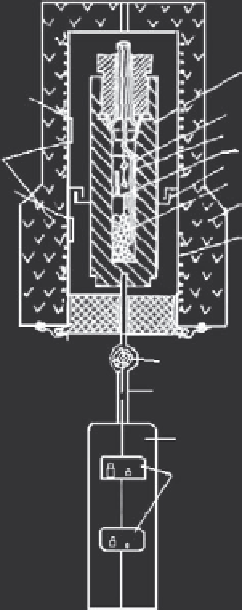Geoscience Reference
In-Depth Information
Figure 3.19 Vertical autoclave mounted in the device
[52]
. (1) Autoclave, (2) thermocouple, (3) baffle, (4)
nutrient, (5) seed holder, (6) furnace, (7) electric
winding, (8) two sets of thermocouples, (9) bellows-type
barrier, (10) axle, (11) counter weight, (12) roller
bearing, and (13) two balance shelves.
1
5
2
3
8
9
4
6
7
12
10
11
13
Pendulum Apparatus
Mass transfer of material under hydrothermal conditions may be determined contin-
uously or periodically from the motion of the center of gravity of a vertical auto-
clave mounted in the device shown schematically in
Figure 3.19 [52]
.
The oscillations of the autoclave are recorded and counted by means of a photo-
relay and pulse counter. Crystal growth can be monitored by observing the change
in the oscillation period of the system. If the crystals are growing, the center of
gravity of the autoclave will move upward, and the oscillation period of the system
will increase. The pendulum apparatus designed by Shternberg is highly useful for
kinetic studies.
Hydrothermal Reaction Cell for Kinetic Studies
Recently, Clark et al., and Evans et al.
[53,54]
developed a large volume reaction
cell for kinetic studies using energy-dispersive powder diffraction. This apparatus
offers a powerful method of measuring reaction rates for processes that involve crys-
talline materials. In addition, this helps to carry out multiphase quantitative analysis


